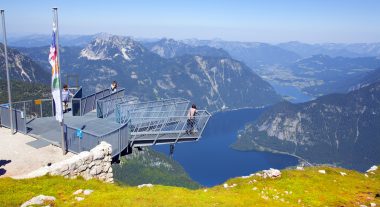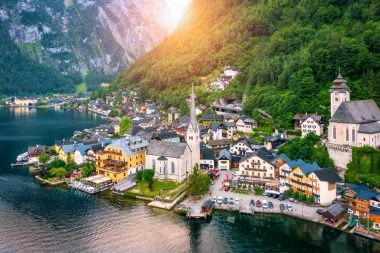The Hallstatt-Dachstein-Salzkammergut region is known for its 7,000-year-old history, its rich culture and the oldest salt mine. But this stretch of land has much more to offer: it also scores with its unique nature. So it’s no wonder that this region was added to the UNESCO World Heritage List in 1997 as the Hallstatt-Dachstein-Salzkammergut Cultural Landscape. Reason enough for us to take a closer look at them.
The most important towns in the Hallstatt-Dachstein-Salzkammergut region include Bad Goisern, Hallstatt, Gosau and Obertraun. The region is especially known to winter sports lovers. Every year, they make a pilgrimage up the mountains with their skis or snowboard in their luggage to undertake rapid rides. But the Dachstein Mountains are not only a real experience in winter, but also have a lot to offer in summer. Namely, a postcard idyll between green meadows and rugged peaks. All in all, an area that is suitable for a holiday at any time of the year.
Active on the Dachstein & Krippenstein
Only 15 minutes by car from Hallstatt, the Dachstein Mountains with their various peaks rise into the air – including the Hoher Dachstein and the Hoher Krippenstein. Just the sight of this landscape amazes you. However, you can immerse yourself in the mountains even more intensively if you decide to do one of the many activities.
In winter, the area is above all an Eldorado for skiers and snowboarders. But beware – in the autumn-winter season 2022/23 there will be no alpine skiing on the Dachstein glacier due to responsibility towards nature and economic efficiency. But that’s no reason to worry, because there are numerous other possibilities for skiing around the Dachstein. On 160 kilometres of groomed slopes, adults and children can let off steam in the Dachstein West ski area. The winter season here runs from 3 December 2022 to 10 April 2023. The Freesports Arena Dachstein Krippenstein, on the other hand, is popular with freeriders – 30 kilometres of the finest deep snow await you there! The Loser ski area is also worth a visit – it is only a 25-minute drive from Hallstatt.
The region is also an excellent starting point for winter and snowshoe hikes. For example, there are three marked trails that lead winter fans to breathtaking viewpoints. Several ski schools and ski rentals complete the offer.
In the warmer seasons, the unique Dachstein caves can be explored. A short walk from the “Koppenrast” inn at the end of Obertraun, along the Traun, is enough, for example, to reach the Koppenbrüller cave. This Dachstein cave inspires young and old and the 50-minute guided tour gives interested parties exciting insights into the underground waterways of the Dachstein interior. The other two caves are in the immediate vicinity: To visit the Giant Ice Cave and the Mammoth Cave, it is best to start at the middle station of the Schönbergalm. From there you can reach both natural jewels in 15 to 20 minutes on foot. In the caves themselves, there are all kinds of highlights such as a suspension bridge, light and music effects or pictures made of white mountain milk and brown iron oxide, which nature itself has drawn.

If, on the other hand, you are drawn up to lofty heights, you can take the panoramic cable car a little further – for example to the summit of the Hoher Krippenstein. There you can expect a breathtaking view of the Dachstein glacier. Don’t miss the 5fingers observation deck either. It protrudes like a hand into an abyss over 400 meters deep. This excursion destination is therefore not for the faint of heart – but those who dare to walk the platform will be rewarded with a spectacular view of Lake Hallstatt or the Inner Salzkammergut.
Starting from the mountain station, there are also a number of hiking trails for families and mountain enthusiasts alike, for example the Heilbronn circular hiking trail. In about three hours, it goes over the Dachstein-Hai and the Heilbronner-Kreuz to the Gjaid valley station. From there you can comfortably take the cable car back to the Hoher Krippenstein.
Another highlight of the region is the “Skywalk”, also known as the World Heritage View. This imposing viewing platform is located on the Salzberg and is thus enthroned 360 meters above the rooftops of Hallstatt. You can reach the vantage point from the Hallstatt Salzbergbahn in just two minutes on foot or you can even take advantage of an elevator. If you want, you can also march up from the center.
Cultural visit to Hallstatt

The Salzkammergut is considered one of the most beautiful regions in Austria and Hallstatt in particular should be visited once in a lifetime. Because the place, which has already been praised by many famous writers, poets, painters, photographers and explorers, really does look like something out of a picture book. Just over an hour’s drive from Salzburg , Hallstatt is an ideal destination for a day trip or weekend getaway. And it gets particularly romantic if you head for the picturesque town by boat.
Even though it is a relatively small place, you should plan at least 3 to 4 hours for the visit, because there is a lot to see. A few highlights that you shouldn’t miss: For the perfect photo, it’s worth taking a walk to the viewing terrace. At the end of the village, directly in front of Haus Zian at Gosaumühlstraße 68, the pretty houses on the shore are particularly beautiful in their field of vision. A visit to the ossuary in St. Michael’s Chapel is also worthwhile. The room, which contains a lot of skulls and bones, has existed since the 12th century. The painted skulls in particular are unique. The reason for this bizarre place is quickly explained: The space at the cemetery is not enough for all the deceased. Therefore, the graves are reopened after 10-15 years, the bones are cleaned, cleaned, partially decorated and housed in the ossuary. Hallstatt’s market square is also particularly charming – you should definitely linger here for a few minutes and be enchanted by the colourful facades. Finally, the “Salt Mine” salt mine also beckons. This is the oldest show mine in the world.
Combine the visit with other wonderful places such as Bad Ischl, the area around the Attersee or the Traunsee, Altaussee, the Fuschlsee, Wolfgangsee or the Mondsee-Irrsee region – depending on how much time you have available.
When is the best time to visit the region?
There is no one-size-fits-all answer to this question, but rather depends on the activities you want to do.
In summer, hikers, water sports enthusiasts, nature lovers, but also culture lovers get their money’s worth. However, Hallstatt is one of the most popular excursion destinations, especially in the warmer months, which can make it a bit crowded on the streets and in the narrow streets. Hotels and tickets should therefore be booked in advance. If you have planned a hike into the Dachstein Mountains or a walk through Hallstatt, it is advisable to start early – even before the typical day trippers. This way you have the mountain or town to yourself, you can take as many postcard-perfect photos as you want, and you can easily find a parking space.
In winter, the region turns into a fairytale landscape and thus has its very own charm. Winter hiking, cross-country skiing and, of course, skiing or snowboarding are all great here. And the rustic Christmas markets also have their charm. Winter is the second busiest tourist season in the region – even during this period, don’t underestimate the crowds. In spring and autumn, on the other hand, things are a bit quieter – these seasons are therefore still very good for a visit.
Getting to the region
Hallstatt can be reached from Vienna in 3.5 hours, from Linz in just under two, from Innsbruck in three and from Salzburg in just under 1.5 hours. There are a variety of travel options, especially from the Salzburg hub. The city is also a particularly good starting point if you only want to visit Hallstatt and do not want to stay overnight in the region.
From Salzburg to Hallstatt
The ÖBB bus no. 150 from the Salzburg bus terminal at Südtiroler Platz takes you to Bad Ischl, from where you change to a regional train that goes to Hallstatt station. Finally, you can take the ferry from the train station directly to Hallstatt’s market square. Attention: The Hallstatt train station, which is actually called Obertraun, is on the other side of the lake. So, if you’re traveling by train, you’ll need to take a ferry.
Alternatively, you can take bus no. 542 to Gosaumühle and change there to bus no. 543 to Hallstatt Lahn (main bus stop, Hallstatt). The same bus continues to the Dachstein-Krippenstein in Obertraun.
A train from Salzburg Central Station will take you to Attnang-Puchheim, where you can change to the regional train to Hallstatt station and then take the ferry from the station to the city centre again.


